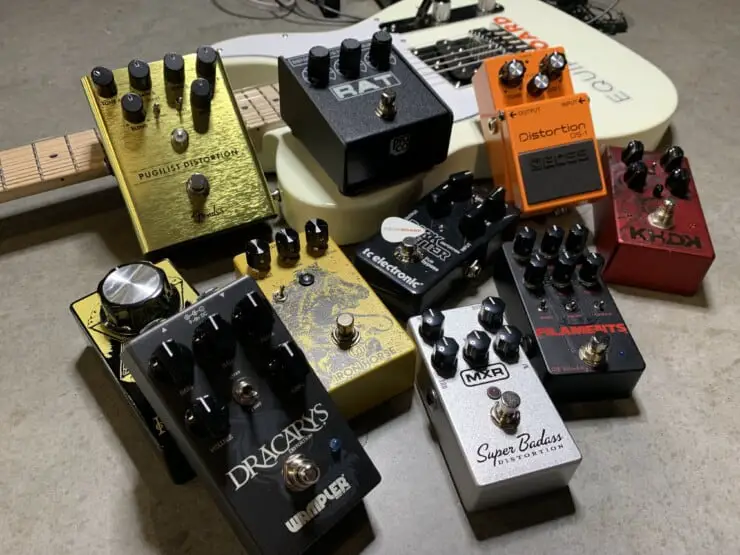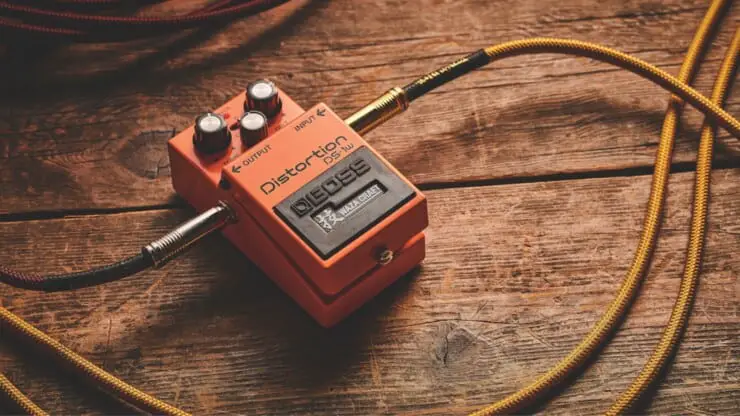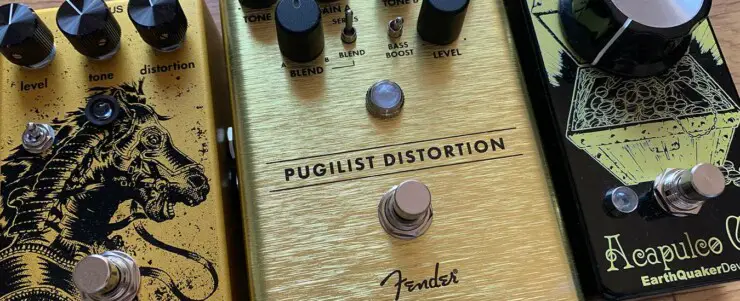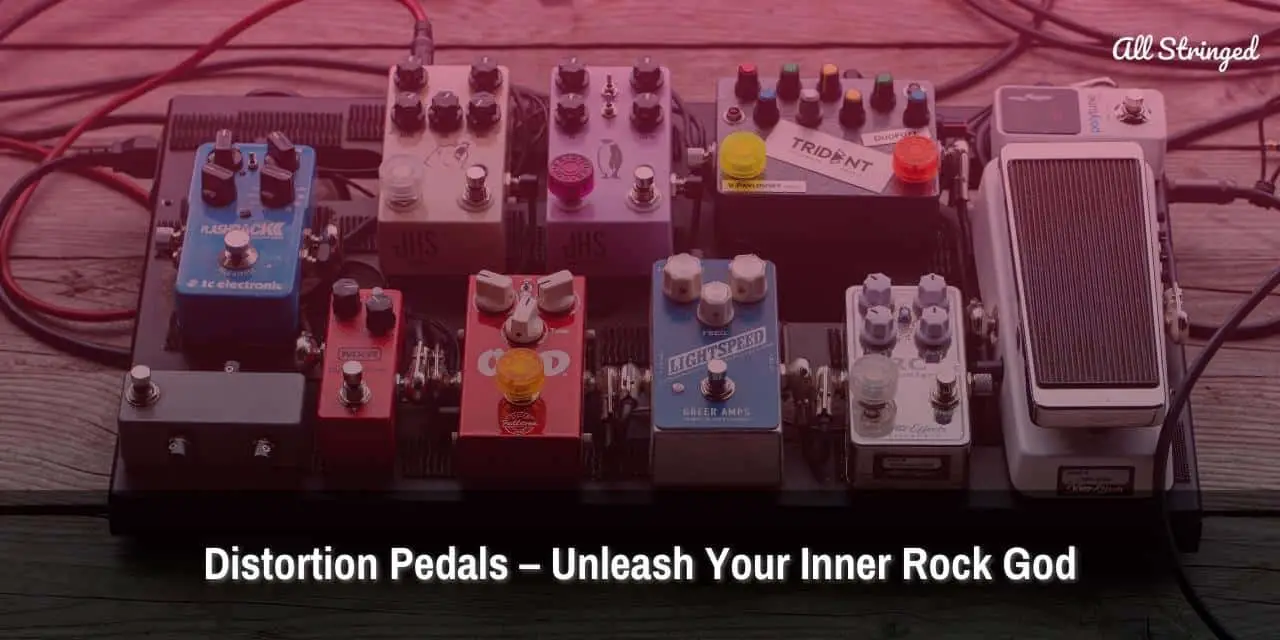Are you ready to take your electric guitar playing to the next level? If you’ve ever dreamed of unleashing your inner rock god, then you’re in for a treat. Introducing the ultimate game-changer for electric guitarists: the distortion pedal. This powerful device has the ability to transform your sound, adding a gritty, edgy, and downright badass tone to your playing. Whether you’re a seasoned pro or just starting out, the distortion pedal is a must-have tool in your arsenal. In this article, we’ll explore the different types of distortion pedals, common features to look for, tips for using them effectively, and how to properly maintain and care for your pedal. Get ready to rock like never before!

>>> Click here to read our review about the Top 5 Best Distortion Pedals <<<
Distortion pedals are essential tools for guitarists looking to add grit and intensity to their sound, and choosing the right one for your style and maintaining it properly can greatly enhance your playing experience.
- There are various types of distortion pedals available, including overdrive, fuzz, and high-gain options, each offering a unique tone and level of distortion.
- Common features found in distortion pedals include gain control, tone shaping options, and bypass switches, allowing for customization and versatility in your sound.
- When choosing a distortion pedal, consider your preferred style of music, the level of distortion desired, and the compatibility with your guitar and amplifier.
- To use a distortion pedal effectively, experiment with different settings, adjust the gain and tone controls to suit your playing style, and be mindful of the pedal’s placement in your signal chain.
- Proper maintenance and care for distortion pedals involve regular cleaning, checking for loose connections, and using a power supply or battery to avoid damage.
Types of Distortion Pedals
Distortion pedals are an essential tool for guitarists looking to add a gritty, edgy, and distorted tone to their sound. These pedals have become a staple in the world of rock, metal, and blues, allowing guitarists to unleash their creativity and push the boundaries of their instrument. With a wide variety of distortion pedals available on the market, it can be overwhelming to choose the right one for your needs. In this section, we will explore the different types of distortion pedals and their unique characteristics.
Overdrive Pedals
Overdrive pedals are often the first choice for guitarists looking to add a touch of distortion to their sound. These pedals are known for producing a warm, smooth, and natural-sounding distortion. They work by driving the signal of the guitar into the amplifier, creating a subtle breakup in the tone. Overdrive pedals are versatile and can be used to achieve a range of tones, from a mild crunch to a more aggressive, bluesy distortion.
Fuzz Pedals
Fuzz pedals are famous for their thick, saturated, and vintage-inspired distortion. These pedals produce a heavily clipped waveform, resulting in a unique and distinctive tone. Fuzz pedals are often associated with classic rock and psychedelic music, as they can create a thick wall of sound and sustain. They are known for their sustain and ability to transform a clean guitar signal into a roaring, fuzzy tone.
Distortion Pedals
Distortion pedals are the most common type of pedals used by guitarists. They offer a wide range of distortion tones, from mild to heavy, and are suitable for various genres of music. Distortion pedals work by amplifying the guitar signal and clipping it to create a distorted sound. They are often used in rock, metal, and punk music, as they can produce aggressive and high-gain tones. Distortion pedals are versatile and can be used to achieve anything from a classic rock crunch to a modern, high-gain metal tone.
Metal Distortion Pedals
Metal distortion pedals are specifically designed to cater to the needs of metal guitarists. These pedals are known for their high-gain, aggressive, and tight distortion tones. They often feature multiple EQ controls, allowing guitarists to shape their tone and cut through the mix. Metal distortion pedals are perfect for achieving heavy palm-muted riffs, blistering solos, and crushing low-end tones.
Hybrid Distortion Pedals
Hybrid distortion pedals combine the characteristics of different types of distortion pedals to offer a unique and versatile tone. These pedals often feature multiple distortion circuits, allowing guitarists to switch between different types of distortion on the fly. Hybrid distortion pedals are ideal for guitarists who want to experiment with different tones and genres without investing in multiple pedals.
Conclusion
Choosing the right distortion pedal is a matter of personal preference and the desired tone you want to achieve. Whether you’re looking for a subtle overdrive, a vintage fuzz, a versatile distortion, or a high-gain metal tone, there is a distortion pedal out there to suit your needs. Experimenting with different types of distortion pedals can help you discover new sounds and expand your sonic palette. So, go ahead, unleash your creativity, and let the distortion pedal take your guitar playing to new heights.
Common Features of Distortion Pedals
Distortion pedals are an essential tool for guitarists looking to add a gritty and aggressive edge to their tone. These pedals are designed to replicate the sound of an overdriven tube amplifier, providing a wide range of distortion options to suit different musical styles and preferences. In this section, we will explore the common features found in distortion pedals, helping you understand what to look for when choosing the right one for your needs.
Gain Control:
The gain control is the heart of a distortion pedal, allowing you to adjust the level of distortion or overdrive. This control determines how much the incoming signal is amplified and clipped, resulting in a more aggressive and distorted tone. Higher gain settings produce heavier and more saturated distortion, while lower settings offer a more subtle overdrive effect.
Tone Control:
Most distortion pedals feature a tone control knob that allows you to shape the overall tonal characteristics of the distorted sound. This control helps you adjust the balance between bass, midrange, and treble frequencies, giving you the flexibility to tailor the pedal’s tone to your liking. Turning the tone control clockwise typically boosts the high frequencies, while turning it counterclockwise emphasizes the low-end response.
Level Control:
The level control, also known as the volume control, adjusts the output level of the pedal. It ensures that the volume remains consistent when engaging the distortion effect, preventing any sudden volume jumps or drops. This feature is particularly useful when switching between clean and distorted tones during a performance.
Footswitch:
A footswitch is a standard feature on most distortion pedals, allowing you to engage or bypass the effect with a simple tap of your foot. This hands-free operation is crucial for live performances, as it enables you to switch between clean and distorted tones seamlessly. Some pedals may also include additional footswitches to toggle between different distortion modes or activate built-in effects like boost or noise gate.
Multiple Distortion Modes:
Many modern distortion pedals offer multiple distortion modes, providing a versatile range of tonal options within a single unit. These modes can include variations of classic distortion types such as overdrive, fuzz, or high-gain distortion. Each mode typically offers a unique tonal character and level of saturation, allowing you to experiment and find the perfect distortion flavor for your playing style.
Built-in Effects:
Some distortion pedals go beyond the basic distortion sound and incorporate additional built-in effects. These effects can include features like built-in reverb, delay, modulation, or even amp simulation. While these extra effects may not be essential for everyone, they can be a convenient and cost-effective solution for guitarists who want to expand their sonic possibilities without investing in separate pedals.
Power Options:
Distortion pedals can be powered by various sources, including batteries or external power supplies. While batteries offer portability, they may drain quickly, requiring frequent replacements. External power supplies, on the other hand, provide a reliable and consistent power source, ensuring optimal performance during gigs or studio sessions. Some pedals also offer the option to use both battery and external power supply for added flexibility.
To summarize, distortion pedals are versatile tools that allow guitarists to add a wide range of distorted tones to their playing. By understanding the common features found in these pedals, such as gain control, tone control, level control, footswitches, multiple distortion modes, built-in effects, and power options, you can make an informed decision when choosing the right distortion pedal to suit your musical preferences and needs.

>>> Click here to read more about Guitar Pedals <<<
Choosing the Right Distortion Pedal for Your Style
When it comes to electric guitar effects, few are as iconic and versatile as the distortion pedal. Whether you’re playing heavy metal, blues, rock, or any other genre that requires a gritty and powerful tone, a distortion pedal can take your playing to the next level. With so many options available on the market, it can be overwhelming to choose the right one for your style. In this section, we will explore the factors to consider when selecting a distortion pedal and provide some recommendations based on different musical styles.
- Gain Range and Tone Control
The first thing to consider when choosing a distortion pedal is the gain range and tone control it offers. The gain range determines how much distortion or overdrive you can achieve, ranging from subtle breakup to heavy saturation. If you play genres like blues or classic rock, a pedal with a lower gain range might be suitable. On the other hand, if you’re into metal or hard rock, a pedal with a higher gain range will give you the desired aggressive tone. Additionally, having control over the tone allows you to shape the sound to your liking, whether you prefer a scooped mid-range or a more balanced tone. - Pedal Types
Distortion pedals come in various types, each with its own unique characteristics. Here are some common types: a. Overdrive Pedals: These pedals provide a mild to moderate level of distortion, replicating the warm and smooth tones of vintage tube amplifiers. Overdrive pedals are ideal for genres like blues, country, and classic rock. b. Fuzz Pedals: Fuzz pedals produce a thick and saturated tone with a distinctive sustain. They are known for their vintage and psychedelic sound, making them popular among players in genres like psychedelic rock and stoner rock. c. High-Gain Distortion Pedals: If you’re into heavy metal or hard rock, high-gain distortion pedals are your best bet. These pedals offer extreme levels of gain, allowing you to achieve the aggressive and tight tone required for these genres. - Versatility
Consider the versatility of the distortion pedal you choose. Some pedals offer a wide range of tonal options, allowing you to dial in different sounds to suit various musical styles. Look for pedals with multiple gain stages, tone-shaping options, and built-in effects like boost or EQ. Having a versatile pedal will enable you to experiment with different sounds and adapt to different playing situations. - Budget
Distortion pedals come in a wide price range, so it’s essential to consider your budget. While it’s tempting to go for the most expensive option, there are plenty of affordable pedals that offer excellent tone and durability. Determine your budget and research pedals within that range, keeping in mind the features and sound quality you’re looking for. - Recommended Distortion Pedals for Different Styles
Here are some recommendations for distortion pedals based on different musical styles:
a. Blues and Classic Rock: Ibanez Tube Screamer, Boss BD-2 Blues Driver, Fulltone OCD.
b. Metal and Hard Rock: Boss MT-2 Metal Zone, MXR Fullbore Metal, Wampler Triple Wreck.
c. Experimental and Shoegaze: Electro-Harmonix Big Muff Pi, EarthQuaker Devices Hoof, Walrus Audio Jupiter.
Here’s a comparison table highlighting the key features of the recommended distortion pedals:
| Pedal | Gain Range | Tone Control | Versatility |
|---|---|---|---|
| Ibanez Tube Screamer | Moderate | 3-band EQ | High |
| Boss MT-2 Metal Zone | High | 3-band EQ | Moderate |
| Electro-Harmonix Big Muff Pi | High | Tone and Sustain | Moderate |
Remember, these are just a few examples, and there are numerous distortion pedals available on the market. It’s essential to try out different pedals and find the one that best suits your playing style and preferences.
In conclusion, choosing the right distortion pedal for your style involves considering factors such as gain range, tone control, pedal types, versatility, and budget. By taking these factors into account and exploring different options, you can find the perfect distortion pedal to enhance your playing and achieve the desired tone for your musical style.

Tips for Using a Distortion Pedal Effectively
Using a distortion pedal can greatly enhance your guitar playing, adding a gritty and powerful edge to your sound. However, to make the most of this effect, it’s important to use it effectively. In this section, we will explore some tips and techniques for getting the best results from your distortion pedal.
Experiment with Gain Settings
One of the key aspects of using a distortion pedal is finding the right balance of gain. The gain control determines the amount of distortion applied to your signal. Start by setting the gain to a moderate level and gradually increase or decrease it until you find the desired tone. Keep in mind that higher gain settings can result in more sustain and a heavier sound, while lower settings can produce a cleaner, crunchier tone.
Shape Your Tone with EQ
Most distortion pedals come with built-in EQ controls, allowing you to shape the tone to your liking. These controls typically include bass, mid, and treble knobs. Experiment with different EQ settings to find the sweet spot for your guitar and playing style. For example, boosting the mids can help your guitar cut through the mix, while reducing the bass can tighten up the low end. Don’t be afraid to tweak the EQ settings until you achieve the desired sound.
Use the Volume Control on Your Guitar
The volume control on your guitar can be a powerful tool when using a distortion pedal. By rolling back the volume knob, you can clean up the sound and reduce the amount of distortion. This technique is particularly useful for creating dynamic and expressive playing. When you need a cleaner sound, simply lower the volume on your guitar, and when you want to unleash the full power of the distortion, crank it up.
Stacking Distortion Pedals
If you’re looking for even more tonal possibilities, consider stacking multiple distortion pedals. By connecting two or more pedals in series, you can create unique and complex sounds. Experiment with different combinations and order of pedals to find the perfect blend of distortion. Keep in mind that stacking too many pedals can sometimes result in a loss of clarity, so it’s important to find the right balance.
Using a Distortion Pedal in Different Genres
Distortion pedals are commonly associated with rock and metal genres, but they can be used effectively in various musical styles. Here are some tips for using a distortion pedal in different genres:
- Blues: Dial back the gain for a smoother and more vintage tone. Use the distortion sparingly to add grit and sustain to your blues licks.
- Punk: Crank up the gain for a raw and aggressive sound. Experiment with faster picking techniques and power chords to achieve that classic punk rock sound.
- Alternative: Use a moderate amount of gain to add texture and depth to your chords and riffs. Experiment with different EQ settings to create a unique and atmospheric tone.
- Metal: Push the gain to the max for a heavy and aggressive tone. Combine palm-muted chugs with fast and precise lead playing to achieve that crushing metal sound.
Conclusion
Using a distortion pedal effectively can greatly enhance your guitar playing and allow you to explore a wide range of tones. Experiment with different gain settings, EQ controls, and stacking options to find the perfect sound for your playing style and musical genre. Remember to have fun and let your creativity flow as you explore the sonic possibilities of your distortion pedal.
Maintenance and Care for Distortion Pedals
Distortion pedals are essential tools for guitarists who want to add a gritty and aggressive edge to their sound. These pedals are designed to create a distorted or overdriven tone by amplifying the signal and clipping the waveform. While distortion pedals are built to withstand heavy use, proper maintenance and care can help prolong their lifespan and ensure optimal performance. In this section, we will discuss some important tips for maintaining and caring for distortion pedals.
Regular Cleaning
One of the simplest yet most effective ways to maintain your distortion pedal is by regularly cleaning it. Over time, dust, dirt, and grime can accumulate on the surface and inside the pedal, affecting its performance. Here are some steps you can follow to clean your distortion pedal:
- Unplug the pedal: Before cleaning, make sure to unplug the pedal from the power source and disconnect it from the guitar.
- Remove the knobs: Gently remove the knobs from the pedal to access the surface beneath them.
- Use a soft cloth: Wipe the surface of the pedal using a soft cloth or microfiber cloth to remove any dust or dirt. Avoid using abrasive materials that could scratch the pedal’s finish.
- Clean the knobs: Clean the knobs separately using a mild cleaning solution and a soft cloth. Ensure they are completely dry before reattaching them to the pedal.
- Inspect the jacks: Check the input and output jacks for any debris or loose connections. Use compressed air or a small brush to remove any dirt or dust.
Preventing Damage
Taking preventive measures can go a long way in protecting your distortion pedal from unnecessary damage. Here are some tips to consider:
- Avoid excessive force: When engaging or disengaging the pedal, avoid applying excessive force. This can prevent damage to the footswitch and internal components.
- Use a power surge protector: Distortion pedals are susceptible to damage from power surges. Invest in a good quality surge protector to safeguard your pedal against sudden voltage spikes.
- Store in a safe place: When not in use, store your distortion pedal in a safe and dry place. Avoid exposing it to extreme temperatures, humidity, or direct sunlight, as these can affect the pedal’s performance and longevity.
Troubleshooting and Repairs
Even with proper care, distortion pedals may encounter issues over time. Here are some common troubleshooting tips and repairs you can try:
- Check the power supply: If your distortion pedal is not turning on or producing sound, check the power supply. Ensure that the power adapter is working correctly and that the pedal is receiving the required voltage.
- Inspect cables and connections: Faulty cables or loose connections can cause signal loss or noise issues. Check all cables and connections, ensuring they are securely plugged in and in good condition.
- Replace worn-out parts: Over time, certain components in the distortion pedal, such as capacitors or resistors, may wear out. If you have experience with electronics, you can consider replacing these parts yourself. Otherwise, it’s best to consult a professional technician.
- Contact customer support: If you encounter persistent issues or are unsure about troubleshooting steps, reach out to the manufacturer’s customer support for assistance. They can provide guidance or recommend authorized service centers for repairs.
To summarize, maintaining and caring for your distortion pedal is crucial to ensure its longevity and optimal performance. Regular cleaning, preventing damage, and troubleshooting common issues can help you get the most out of your pedal and enhance your guitar playing experience. Remember to always follow the manufacturer’s instructions and consult professionals when needed.
Conclusion
In conclusion, the world of electric guitar playing has been forever transformed by the incredible power and versatility of distortion pedals. These little devices have the ability to take your guitar tone from clean and pristine to a roaring beast of rock and roll.
Throughout this article, we explored the different types of distortion pedals available, ranging from classic overdrive to heavy metal distortion. We also discussed the common features that you can expect to find in these pedals, such as gain control, tone shaping options, and built-in effects.
Choosing the right distortion pedal for your style is crucial, as it can greatly impact your overall sound. Whether you’re a blues enthusiast, a metalhead, or a classic rock aficionado, there is a distortion pedal out there that will perfectly complement your playing style and help you achieve the desired tone.
To make the most out of your distortion pedal, we provided some valuable tips on how to use it effectively. From adjusting the gain and tone settings to experimenting with different pedal placements in your signal chain, these techniques will help you unlock the full potential of your pedal and create unique sounds that will set you apart from the crowd.
Lastly, we emphasized the importance of proper maintenance and care for your distortion pedal. By keeping it clean, checking for any loose connections, and using a power supply instead of batteries, you can ensure that your pedal will continue to deliver its mind-blowing distortion for years to come.
So, whether you’re a seasoned guitarist looking to add some extra grit to your sound or a beginner eager to explore the world of electric guitar effects, a distortion pedal is an absolute must-have. It’s time to unleash your inner rock god and take your guitar playing to new heights with the ultimate game-changer – the distortion pedal!
Frequently Asked Questions for Distortion Pedal
What is a distortion pedal and how does it work?
A distortion pedal is an audio effects device used in electric guitar and bass guitar setups to alter the sound by adding distortion or overdrive. It works by amplifying the guitar signal and clipping the waveform to create a distorted sound.
What are the different types of distortion pedals available?
There are several types of distortion pedals available, including overdrive, fuzz, and high-gain distortion. Overdrive pedals produce a mild distortion, fuzz pedals create a fuzzy and saturated tone, and high-gain distortion pedals provide a heavy and aggressive distortion sound.
How do I choose the right distortion pedal for my needs?
Choosing the right distortion pedal depends on your playing style, musical genre, and personal preferences. Consider factors such as the type of distortion you want, the level of gain, tonal characteristics, and the overall sound you are aiming for. It’s also helpful to try out different pedals and read reviews to find the one that suits your needs best.



